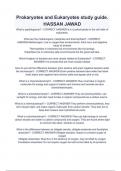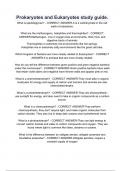Prokary Samenvattingen, Aantekeningen en Examens
Op zoek naar een samenvatting over Prokary? Op deze pagina vind je 336 samenvattingen over Prokary.
Pagina 3 van de 336 resultaten
Sorteer op
Prokaryotes and Eukaryotes study guide. HASSAN JAWAD
Prokaryotes and Eukaryotes study guide with complete solution
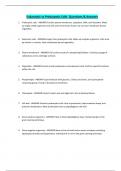
-
Eukaryotic vs Prokaryotic Cells Questions & Answers
- Tentamen (uitwerkingen) • 2 pagina's • 2024
-
- $10.49
- + meer info
Eukaryotic vs Prokaryotic Cells Questions & Answers 1. Prokaryotic cells - ANSWER-Contain plasma membrane, cytoplasm, DNA, and ribosome. Make up single-celled organisms and cells arise from binary fission. Do not have membrane-bound organelles. 2. Eukaryotic cells - ANSWER-Larger than prokaryotic cells. Make up complex organisms. Cells arise by mitosis or meiosis. Have membrane-bound organelles. 3. Plasma membrane - ANSWER-Cell surface made of a phospholipid bilayer. Controls passage of...
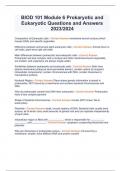
-
BIOD 101 Module 6 Prokaryotic and Eukaryotic Questions and Answers 2023/2024
- Tentamen (uitwerkingen) • 14 pagina's • 2024
-
Ook in voordeelbundel
-
- $13.49
- + meer info
BIOD 101 Module 6 Prokaryotic and Eukaryotic Questions and Answers 2023/2024 Composition of Eukaryotic cells - Correct Answer membrane-bound nucleus (which houses DNA) and specific organelles Difference between animal and plant eukaryotic cells - Correct Answer Animal have no cell walls, plant have rigid cell walls Main differences between prokaryotic and eukaryotic cells - Correct Answer Prokaryotic are less complex, lack a nucleus and other membrane-bound organelles, are smaller, and or...
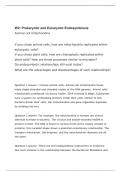
-
BIOL202 Week 2 Discussion; Prokaryotic and Eukaryotic Endosymbiosis
- Overig • 2 pagina's • 2023
- Ook in voordeelbundel
-
- $19.49
- + meer info
Week 2: Prokaryotic and Eukaryotic Endosymbiosis Animal cell mitochondria • If you chose animal cells, how are mitochondria replicated within eukaryotic cells? • If you chose plant cells, how are chloroplasts replicated within plant cells? How are these processes similar to microbes? • Do endosymbotic relationships still exist today? • What are the advantages and disadvantages of such relationships?
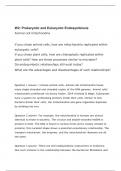
-
BIOL202 Week 2 Discussion Prokaryotic and Eukaryotic Endosymbiosis APU
- Overig • 2 pagina's • 2024
- Ook in voordeelbundel
-
- $17.99
- + meer info
Week 2:ProkaryoticandEukaryoticEndosymbiosis Animalcellmitochondria • Ifyouchoseanimalcells,howaremitochondriareplicatedwithineukaryoticcells? • Ifyouchoseplantcells,howarechloroplastsreplicatedwithinplantcells?Howaretheseprocessessimilartomicrobes? • Doendosymboticrelationshipsstillexisttoday? • Whataretheadvantagesanddisadvantagesofsuchrelationships?

-
OpenStax Microbiology Test Bank Chapter 4: Prokaryotic Diversity.
- Tentamen (uitwerkingen) • 18 pagina's • 2023
- Ook in voordeelbundel
-
- $11.49
- + meer info
OpenStax Microbiology Test Bank Chapter 4: Prokaryotic Diversity. OpenStax Microbiology Test Bank Chapter 4: Prokaryotic Diversity Page 1 of 17 Chapter 4: Prokaryotic Diversity * = Correct answer Multiple Choice 1. Which is the best example of a population? A. all the microbes living in a particular area B. all the microbes of a particular domain living in a particular area C. all the microbes of a single species living in a particular area* D. all the microbes living within the same ...
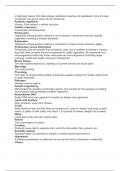
-
Acellular organisms Viruses. Exist without a cellular structure. Cellular organisms Prokaryotes and Eukaryotes. Prokaryotes Organisms whose genetic material is not enclosed in membrane and lack specific organelles including a nucleus (bacteria). Eukaryote
- Tentamen (uitwerkingen) • 18 pagina's • 2024
-
- $11.49
- + meer info
Acellular organisms Viruses. Exist without a cellular structure. Cellular organisms Prokaryotes and Eukaryotes. Prokaryotes Organisms whose genetic material is not enclosed in membrane and lack specific organelles including a nucleus (bacteria). Eukaryotes Organisms whose genetic material is enclosed in nucleus (fungi, protozoa, algae). Prokaryotes versus Eukaryotes Prokaryotic cells are smaller than eukaryotic cells, and in addition to lacking a nucleus, they lack other complex interna...
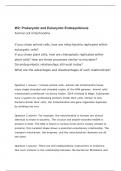
-
BIOL202 Week 2 Discussion; Prokaryotic and Eukaryotic Endosymbiosis
- Overig • 2 pagina's • 2023
-
- $18.49
- + meer info
Week 2: Prokaryotic and Eukaryotic Endosymbiosis Animal cell mitochondria • If you chose animal cells, how are mitochondria replicated within eukaryotic cells? • If you chose plant cells, how are chloroplasts replicated within plant cells? How are these processes similar to microbes? • Do endosymbotic relationships still exist today? • What are the advantages and disadvantages of such relationships?
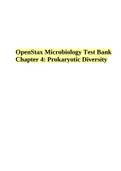
-
OpenStax Microbiology Test Bank Chapter 4: Prokaryotic Diversity
- Tentamen (uitwerkingen) • 18 pagina's • 2023
-
- $16.49
- + meer info
OpenStax Microbiology Test Bank Chapter 4: Prokaryotic Diversity. Which term best describes the relationship between pathogenic bacteria and humans? A. amensalism B. commensalism C. parasitism* D. predation Difficulty: Moderate ASM Standard: 23 4. Which of the following is not a class within the phylum Proteobacteria? A. Alphaproteobacteria B. Betaproteobacteria C. Deltaproteobacteria D. Omegaproteobacteria* Difficulty: Easy ASM Standard: N/A 5. Which of the following correctly cha...

Studiestress? Voor verkopers op Stuvia zijn dit juist gouden tijden. KA-CHING! Verdien ook aan je samenvattingen en begin nu met uploaden. Ontdek alles over verdienen op Stuvia

